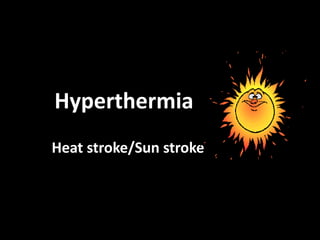Report
Share

Recommended
Recommended
More Related Content
Similar to Hyperthermia.pptx
Similar to Hyperthermia.pptx (20)
Hypothermia in Trauma Victims:- complication and its prevention

Hypothermia in Trauma Victims:- complication and its prevention
Environmental factors in exercise and sports performance

Environmental factors in exercise and sports performance
Environmental factors affecting athletic performance

Environmental factors affecting athletic performance
Recently uploaded
Recently uploaded (20)
Kanchipuram Escorts 🥰 8617370543 Call Girls Offer VIP Hot Girls

Kanchipuram Escorts 🥰 8617370543 Call Girls Offer VIP Hot Girls
The Mariana Trench remarkable geological features on Earth.pptx

The Mariana Trench remarkable geological features on Earth.pptx
Role of AI in seed science Predictive modelling and Beyond.pptx

Role of AI in seed science Predictive modelling and Beyond.pptx
Genome Projects : Human, Rice,Wheat,E coli and Arabidopsis.

Genome Projects : Human, Rice,Wheat,E coli and Arabidopsis.
COMPOSTING : types of compost, merits and demerits

COMPOSTING : types of compost, merits and demerits
FAIRSpectra - Enabling the FAIRification of Spectroscopy and Spectrometry

FAIRSpectra - Enabling the FAIRification of Spectroscopy and Spectrometry
Selaginella: features, morphology ,anatomy and reproduction.

Selaginella: features, morphology ,anatomy and reproduction.
PATNA CALL GIRLS 8617370543 LOW PRICE ESCORT SERVICE

PATNA CALL GIRLS 8617370543 LOW PRICE ESCORT SERVICE
Use of mutants in understanding seedling development.pptx

Use of mutants in understanding seedling development.pptx
Human & Veterinary Respiratory Physilogy_DR.E.Muralinath_Associate Professor....

Human & Veterinary Respiratory Physilogy_DR.E.Muralinath_Associate Professor....
Thyroid Physiology_Dr.E. Muralinath_ Associate Professor

Thyroid Physiology_Dr.E. Muralinath_ Associate Professor
Efficient spin-up of Earth System Models usingsequence acceleration

Efficient spin-up of Earth System Models usingsequence acceleration
X-rays from a Central “Exhaust Vent” of the Galactic Center Chimney

X-rays from a Central “Exhaust Vent” of the Galactic Center Chimney
Pteris : features, anatomy, morphology and lifecycle

Pteris : features, anatomy, morphology and lifecycle
Hyperthermia.pptx
- 2. • Elevated body temperature due to failed thermoregulation • Occurs when a body produces or absorbs more heat than it dissipates
- 3. Thermoregulation Achieved by combined action of • Peripheral Thermoreceptors (Skin, Abd. Viscera, M. mem:, Spinal cord, Great veins) • Central Thermodetectors (Pre-optic area of ant. hypothalamus)
- 4. Thermoregulation Consists of neural and hormonal components • Decreased body temp. causes Increase in the secretion of adrenaline, thyroxin, thyrotropic hormone • Increased body temp. causes decrease in the secretion of adrenaline, thyroxin, thyrotropic hormone
- 5. Heat production in the body • intracellular oxidative & other processes • Liver and heart • Muscles (80%) • From exterior by radiation, conduction and convection
- 6. Heat loss from the body • Conduction, convection and evaporation • Lungs • Feces • urine
- 7. Etiology of Heat stroke • High environmental temp. and humidity • Prolonged and severe muscular exertion • Limited supply of drinking water • Anhydrosis or hypohydrosis • Ill ventilated rooms • Over crowding • Less capability of heat tolerance • Dehydration • Neurogenic hyperthermia occurs due to the poisoning with strychnine, mycotoxins and iodide
- 8. Pathogenesis Heat stroke Damage to the CNS Tachycardia Dyspnea Convulsion Coma Resp. failure Death
- 9. Clinical signs • High elevation of body temp. (106-110oF) • Tachycardia, dyspnea, decreased pulse rate • Open mouth breathing • Protrusion of tongue • Frothy discharge from mouth and nostrils • Anhydrosis • Stumbling, animal trying to lie down • Polydipsia, animal seeks cool places • Collapse, convulsions, coma and death
- 10. Treatment/management • Well ventilated shady rooms • Cold application (ice cold water, ice blocks, ice cold rectal enema) • Adequate drinking water • Fluid therapy • Corticosteroids (prevent cerebral edema) • Supportive therapy
- 11. Hypothermia • Decrease of body temperature due to the excessive loss of heat or insufficient production. This condition is not common in tempered areas of the world. It is particularly seen in cold, wet, and windy weather.
- 12. Etiology • Exposure to excessively cold air temperature (winter season) • Decreased muscular activity in new born and old animals e.g. parturient paresis, acute ruminal impaction • Reduction in metabolic activities such as hypoglycemia, hypocalcaemia, acidosis, and electrolytes (potassium) imbalance • Peripheral vasodilatation as in shock • Anesthesia • Damage to thermo-regulatory center • Profuse diarrhea particularly in winter
- 13. Clinical signs • Sub-normal body temperature, cold skin and extremities • Decrease in respiratory and pulse rate • Shallow breathing, depression, lethargy • In terminal stages, low cardiac output (bradycardia) leading to hypoxia, coma and death
- 14. Treatment • Attempt should be made to rise the body temperature by providing blanket or gas/electrical heater, keep the animal in preheated rooms. • Administer pre-warmed dextrose solution • Corticosteroids may be used to prevent shock • Rectal enemata with Luke-warm water may help in rising core body temperature • Supportive therapy with B complex may help in enhance the metabolic activity